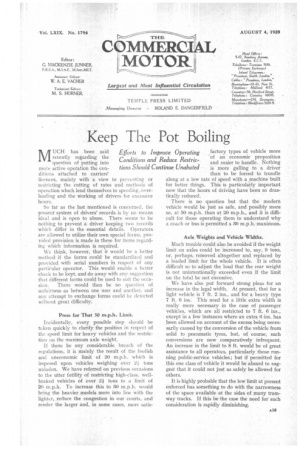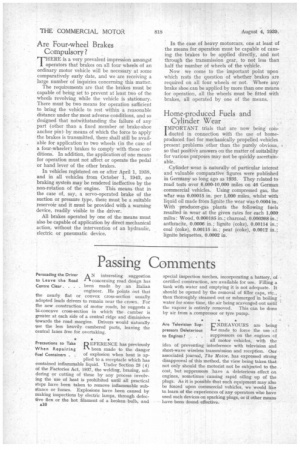Keep The Pot Boiling
Page 17

Page 18

If you've noticed an error in this article please click here to report it so we can fix it.
MUCH has been said recently regarding the question of putting into more active operation the conditions attached to carriers' licences, mainly with a view to preventing or restricting the cutting of rates and methods of operation which lend themselves to speeding, overloading and the Working of drivers for excessive hours.
So far as the last mentioned is concerned, the present system of drivers' records is by no means ideal and is open to abuse. There seems to be nothing to prevent a driver keeping two records which differ in the essential details. Operators are allowed to utilize their own special forms, provided provision is made in these for items regarding which information is required.
We think, however, that it would be a better method if the forms could be standardized and provided with serial numbers in respect of any partkular operator. This would enable a better check to be kept, and do away with any suggestion that different forms could be used to suit the occa sion. There would then be no question of unfairness as between one user and another, and any attempt to exchange forms could be detected without great difficulty.
Press for That 30 m.p.h. Limit.
Incidentally, every possible step should be taken quickly to clarify the position in respect of the speed limit for heavy vehicles and the restriction on the maximum axle weight.
If there be any considerable breach of the regulations, it is mainly the result of the foolish and uneconomic limit of 20 m.p.h. which is imposed upon vehicles weighing over 2i tons unladen. We have referred on previous occasions to the utter futility of restricting high-class, wellbraked vehicles of over 21 tons to a limit of 20 m.p.h. To increase this to 30 m.p.h. would bring the heavier models more into line with the lighter, _reduce the congestion in our courts, and render the larger and, in some cases, more satis factory types of vehicle more of an economic proposition and easier to handle. Nothing is more galling to a driver than to be forced to trundle along at a low rate of speed with a machine built for better things. This is particularly important now that the hours of driving have been so drastically reduced.
There is no question but that the modern vehicle would be just as safe, and possibly more so, at 30 m.p.h. than at 20 m.p.h., and it is difficult for those operating them to understand why a coach or bus is permitted a 30 m.p.h. maximum.
Axle Weights and Vehicle Widths.
Much trouble could also be avoided if the weight limit on axles could be increased to, say, 9 tons, or, perhaps, removed altogether and replaced by a loaded limit for the whole vehicle. It is often difficult so to adjust the load that the rear weight is not unintentionally exceeded even if the limit on the total be not excessive.
We have also put forward strong pleas for an increase in the legal width. At present, that for a light vehicle is 7 ft. 2 ins., and for a heavy type 7 ft. 6 ins. This need for a little extra width is really more necessary in the case of passenger vehicles, which are all restricted to 7 ft. 6 ins., except in a few instances where an extra 6 ins, has been allowed on account of the excess being necessarily caused by the conversion of the vehicle from solid to pneumatic tyres, but, of course, such conversions are now comparatively infrequent. An increase in the limit to 8 ft. would be of great assistance to all operators, particularly those running public-service vehicles; but if permitted for this one class of vehicle it would be absurd to suggest that it could not just as safely be allowed for others.
It is highly probable that the low limit at present enforced has something to do with the narrowness of the space available at the sides of many tramway tracks. If this be the case the need for such consideration is rapidly diminishing. Are Four-wheel Brakes Compulsory? THERE is a very prevalent impression amongst 1 operators that brakes on, all four wheels of an ordinary motor vehicle will be necessary at some comparatively early date, and we are receiving a large number of inquiries concerning this matter. The requirements are that the brakes must be capable of being set to prevent at least two of the wheels revolving while the vehicle is stationary. There must be two means for operation sufficient to bring the vehicle to rest within a reasonable distance under the most adverse conditions, and so designed that notwithstanding the failure of any part (other than a fixed member or brake-shoe anchor pin) by means of which the force to apply the brakes is transmitted, there shall still be available for application to two wheels (in the case of a four-wheeler) brakes to comply with these conditions. In addition, the application of one means for operation must not affect or operate the pedal or hand lever of the other brakes. In vehicles registered on or after April 1, 1938, and in all vehicles from October 1, 1943, no braking system may be rendered ineffective by the non-rotation of the engine. This means that in the case of, say, a servo-operated brake of the suction or pressure type, there must be a suitable reservoir and it must be provided with a warning device, readily visible to the driver. All brakes operated by one of the means must also be capable of application by direct mechanical action, without the intervention of an hydraulic, electric or pneumatic device. In the case of heavy motorcars, one at least of the means for operation must be capable of causing the brakes to be applied directly, and not through the transmission gear, to not less than half the number of wheels of the vehicle. Now we come to the important point upon which rests the question of whether brakes are required on all four wheels or not. Where any brake shoe can be applied by more than one means for operation, all the wheels must be fitted with brakes, all operated by one of the means.
Home-produced Fuels and Cylinder Wear I MPORTANT trials that are now being con ducted in connection with the use of homeproduced fuel for mechanically propelled vehicles present problems other than the purely obvious, so that positive answers on the matter of suitability for various purposes may not be quickly ascertainable. Cylinder wear is naturally of particular interest and valuable comparative figures were published in Germany so long ago as 1935. They related to road tests over 6,000-10,00() miles on 46 German commercial vehicles. Using compressed gas, the wear was 0.00015 in. per 1,000 miles, whilst with liquid oil made from lignite the wear was 0.0004 in. With producer-gas plants the following fuels resulted in wear at the given rates for each 1,000 miles: Wood, 0.000185 in.; charcoal, 0.000368 in.; anthracite, 0.0006 in.; lignite (coke), 0.00114 in.; coal (coke), 0.00115 in.; peat (coke), 0.0012 in.; lignite briquettes, 0.0002 in.




































































